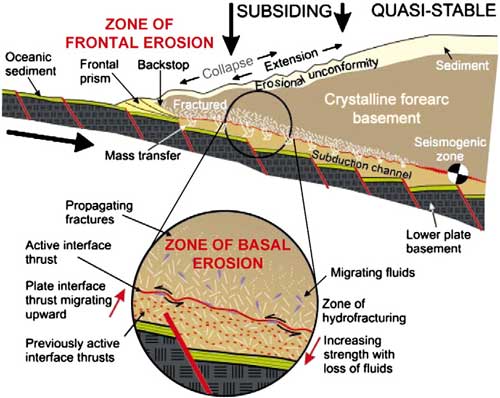 |
Subduction
erosion: rates, mechanisms, and its role in
arc magmatism and the evolution of the continental
crust and mantle |
Charles
R. Stern1
1Department
of Geological Sciences, University of Colorado, Boulder,
Colorado, 80309-0399 USA, Charles.Stern@colorado.edu
This webpage is a summary of: Stern,
C.R. (2011). Subduction erosion: Rates, mechanisms,
and its role in arc magmatism and the evolution of
the continental crust and mantle, Gondwana
Research, doi:10.1016/j.gr.2011.03.006.
Subduction erosion occurs at all convergent
plate boundaries, even if they are also accretionary
margins. Frontal subduction erosion results from a
combination of erosion and structural collapse of the
forearc wedge into the trench. Basal subduction
erosion results from abrasion and hydrofracturing above
the subduction channel (Figure 1).

Figure 1. Cross-section, modified
from von Huene et al. (2004), illustrating the components
of the forearc wedge and different processes involved
in subduction erosion. The subduction channel initially
is filled with both oceanic sediment and debris eroded
off the forearc wedge surface that accumulates in the
frontal prism. Basal erosion results in mass transfer
from the bottom of the forearc wedge to the lower plate
as dislodged fragments are dragged into the subduction
channel. As pore fluid is lost from the sediments in
the channel, the strength of coupling between the two
plates increases and the seismogenic zone begins.
High rates of subduction
erosion are associated with relatively high convergence
rates (> 60 mm/yr)
and low rates of sediment supply to the trench (< 40
km2/yr). This implies a narrow and topographically
rough subduction channel which is neither smoothed
out nor lubricated by fine-grained water-rich turbidites
such as are transported into the mantle below accreting
convergent plate boundaries. Rates of subduction erosion
may be > 440 km3/km/my. They vary temporally
as a function of these same factors, and because of
the subduction of buoyant features such as seamount
chains, volcanic plateaus, island arcs and
oceanic spreading ridges, which weaken the forearc
wedge.
Some revised estimates of long-term
rates of subduction erosion are:
- SW Japan (≥ 30
km3/km/my
since 400 Ma);
- SW USA (≥ 30
km3/km/my since 150 Ma);
- Peru and northern
Chile (50-70 km3/km/my since 150 Ma);
- central
(115 km3/km/my since 30 Ma);
- southernmost
Chile (30-35 km3/km/my since
15 Ma).
These are higher than in previous
compilations (Stern, 2011).
Globally, subduction erosion
is responsible for > 1.7 Armstrong Units
(1 AU = 1 km3/yr) of crustal loss, 33% of
the ~ 5.25 AU of yearly total crustal loss. This is
more than any of either sediment subduction (1.65 AU),
continental lower crustal delamination (≥ 1.1
AU), crustal subduction during continental collision
(0.4 AU), or subduction of rock-weathering-generated
chemical solute dissolved in oceanic crust
(0.4 AU). The paucity of pre-Neoproterozoic
blueschists suggests that global rates of subduction
erosion were probably greater in the remote past, perhaps
due to higher plate convergence rates.
Subducted sediments
and crust removed from the over-riding forearc wedge
by subduction erosion may remain in the crust, either
underplated below the wedge, or carried deeper into
the source region of arc magmatism. There, they may
be incorporated into arc magmas via either dehydration
of the subducted slab and the transport of their soluble
components into the overlying mantle wedge, and/or
bulk melting of the subducted crust to produce adakites.
In selected locations such as Chile, Costa Rica,
Japan and SW USA, there are
temporal and spatial correlations between the
crustal isotopic characteristics of arc magmas and
episodes or areas of enhanced subduction erosion.
Nevertheless,
most subducted crust and sediment (> 90%, i.e., > 3.0
AU) is transported deeper into the mantle and neither
underplated below the forearc wedge nor incorporated
in arc magmas. The total current rate of return of
continental crust into the deeper mantle, the most
important process being subduction erosion,
is equal to or greater than the rate
at which the crust is being replaced by magmatic activity.
This indicates that currently, the continental
crust is probably shrinking slowly. Rates
of crustal growth may have been episodically more rapid
in the past, most likely at times of supercontinent
breakup. Conversely, rates of crustal destruction
may have also been higher during times of supercontinent
amalgamation (Stern & Scholl, 2010; Santosh,
2010).
The supercontinent cycle thus controls
the relative rates of growth and destruction of the
continental crust. Subduction erosion plays an important
role in producing and maintaining this cycle by transporting
radioactive elements from the crust into the mantle.
Geochemical studies on intraplate and "hotspot" lavas
report trace-element and isotopic evidence for a component
of recycled sediment and/or continental crust. This
could thus be explained by sediment and/or forearc
crust subducted into the mantle by subduction
erosion, contributing to the melt source.
References
-
Santosh, M., 2010. A synopsis of recent conceptual
models on supercontinent tectonics in relation to mantle
dynamics, life evolution and surface environment. Journal
of Geodynamics 50, 116–133.
-
-
Stern, R.J., Scholl, D.W., 2010. Yin and yang of
continental crust creation and destruction by plate
tectonic processes. International Geology Review 52,
1–31.
-
von Huene, R., Ranero, C., Vannucchi, P., 2004.
Generic model of subduction erosion. Geology 32,
913–916.
last updated 15th
June, 2011 |
